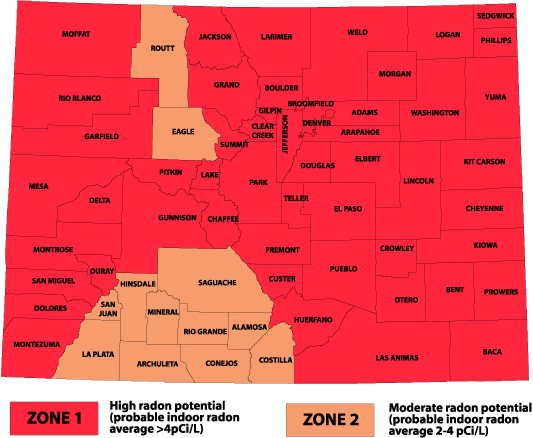Radon Facts
Living in a radon gas filled home with 4 pCi/L over 12 years is like smoking 10 packs of cigarettes per day or working for 5 years in a uranium mine
Twenty-two thousand people die from lung cancer each year in the United States from exposure to indoor radon
Radon gas is the 2nd leading cause of lung cancer in North America
What is Radon?
Why is Radon Dangerous?
How to Test Your Home for Radon?
Perform a simple, short-term test in your home. You can do it yourself and it takes 48 to 96 hours to complete. You should keep windows closed 12 hours prior to testing your house.
A coupon for $15 test kits is available on the Colorado Department of Public Health and Environment (CDPHE) website. After testing, mail the test kit to the address provided; results will be mailed to you.
If radon levels in your home are high:
- A mitigation system should be installed if the concentration of radon is more than 4 pCi/L. These systems should include sealing cracks and openings and installing PVC piping and a fan to remove radon gas, to prevent radon from entering your home.
- Find a National Environmental Health Association (NEHA) certified mitigation contractor in Colorado who can install a radon mitigation system.
Can Radon Make Me Sick?
When a person is exposed to radon over many years the exposure can increase the risk of lung cancer . Radon is the second-leading cause of lung cancer in the United States; only smoking causes more lung cancer. Radon is the leading cause of lung cancer in non-smokers.
Each year, about 20,000 deaths in the United States are attributed to radon-caused lung cancer. Risk of lung cancer from radon is almost 10 times higher for smokers compared to those who have never smoked. Smoking and radon together create a greater risk of lung cancer than either one alone.
Who is at Risk?
- Everyone exposed to radon over a long period of time is at risk for lung cancer.
- Smokers are at higher risk of lung cancer. Exposure to a combination of smoking and radon creates a greater risk than either factor alone.
- While some studies have reported that children are at greater risk than adults for certain types of cancer from radiation, currently there is no conclusive data that their radon risk is greater than adults.
- In Colorado we have high levels of radon in our soils. An EPA model of indoor air radon levels indicates that most of the counties in Colorado have average levels greater than 4 picocuries per liter (pCi/L), which is the level at which EPA recommends radon mitigation.
To Learn More About Radon in Colorado, click HERE
For More Information Regarding Radon Gas and Mitigation, click HERE
Colorado Radon Zones
The U.S. EPA and the U.S. Geological Survey have evaluated the radon potential in the U.S. and have developed this map is to assist National, State, and local organizations to target their resources and to assist building code officials in deciding whether radon-resistant features are applicable in new construction. This map is not intended to be used to determine if a home in a given zone should be tested for radon. Homes with elevated levels of radon have been found in all three zones. All homes should be tested regardless of geographic location. The map assigns each of the 3,141 counties in the U.S. to one of three zones based on radon potential. Each zone designation reflects the average short-term radon measurement that can be expected to be measured in a building without the implementation of radon control methods. The radon zone designation of the highest priority is Zone 1.
Radon Resource Links
https://www.epa.gov/radon
https://www.epa.gov/radon/publications-about-radon

